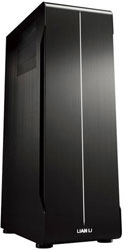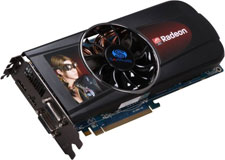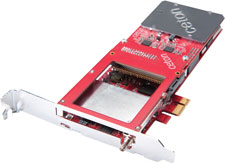Holiday 2010 System Builder's Guide
by AnandTech Staff, edited by Jarred Walton on November 19, 2010 2:00 AM EST- Posted in
- Guides
- Systems
- Holiday 2010
Alan's Ultimate HTPC: Bringing Total Entertainment to the Living Room
Our final build is for those of you who do not like to compromise with your HTPC. Are you tired of hooking up multiple streaming boxes to get all your internet content, NAS for secondary streamers, and another gaming system as well? There are numerous users out there, myself included, that love HTPC as well as gaming. There are many ways to skin the proverbial HTPC cat; this guide is for those of you who want it all in one box on your big screen. There will be sacrifices however, and those come in the size department and in the old pocket book. If you're looking for a small, quiet HTPC that isn't as powerful but doesn't cost an arm and a leg, go look at what Ganesh is pushing.
| Alan's Ultimate HTPC | ||
| Hardware | Component | Price |
| Processor |
Phenom II X6 1090T Black Edition (Thuban 45nm, 3.2GHz, 6x512K L2, 6MB L3, 125W) |
$210 |
| CPU HSF | Noctua NH-D14 | $75 |
| Motherboard | MSI 890FXA-GD70 (AMD 890FX AM3) | $200 |
| Video | Sapphire Radeon HD 5870 1GB (100281-3SR) | $300 |
| GPU HSF | Arctic Cooling Accelero Xtreme | $57 |
| TV Tuner | Ceton InfiniTV4 CableCARD Quad-Tuner | $400 |
| Memory |
G.Skill Ripjaws 2x4GB DDR3-1600 CL9 (F3-12800CL9D-8GBRL) |
$150 |
| OS Drive (SSD) | OCZ Vertex 2 120GB ($20 MIR) | $210 |
| Misc | Icy Dock MB882SP-1S-1B | $20 |
| Hard Drives | 3 x Western Digital Green 2TB (WD20EARS) | $300 |
| Optical Drive | LG UH10LS20 Blu-ray Combo Drive | $85 |
| Case | Lian Li PC-X2000F | $300 |
| Power Supply | Seasonic SS-560KM 560W (80 Plus Gold) ($15 MIR) | $115 |
| Mouse | Razer Mamba | $110 |
| Keyboard | Logitech diNovo Edge | $157 |
| Software | Windows 7 Professional 64-bit (OEM) | $135 |
| Software | Hipporemote Pro | $5 |
| Software | PowerDVD 10 Ultra | $90 |
| Misc | Powermat for iPhone 3GS (PMM-1PB-B2A) | $41 |
| Total System Price | $3015 | |

The first thing to look at for an HTPC is the case, and the most important feature in the case of an HTPC is noise. This is the major problem with multipurpose machines. Gaming cases tend to stay cool but also tend to be noisy and filled with enough LEDs to be mistaken for a flight beacon; after all gamers tend to want to highlight all their high-end hardware. Finding components that will both be cool enough for gaming and quiet enough for a home theater is the key here. A great best of both worlds case is the Lian Li PC-X2000F. At $299 from Newegg as of this writing, the case is pricey, but it currently sports a $200 saving (though that may disappear soon). At that price, I think it is an excellent buy for a home theater/gaming enthusiast.
New to this version is USB 3.0 support and a redesigned case layout. With five 140mm fans, dust filters, and anti vibration solutions, the air-cooling is both highly effective and extremely quiet. Sporting seven HDD bays with the installed back plates for hot-swappable fun, this case has plenty of room for media drives; just make sure your motherboard or RAID card have enough SATA connectors.
Speaking of storage, currently 2TB WD20EARS drives are shipping for $100 and are a great way to expand your media storage capabilities and tend to run on the quiet side of things—no need for a NAS when your HTPC case holds enough traditional HDDs to feed every other device in your home with media! The case is limited to 3.5" drives, but throwing your favorite SSD into an Icy Dock or similar device will allow you to push it right into one of the HDD back plates to get your OS and applications loading at high speed with no noise whatsoever.

For the GPU, I chose AMD because of the bitstreaming support for HD audio codecs. We can argue about performance with the 5870 and 6870, but the 5870 has been around enough that aftermarket cooling solutions are readily available. Add a Noctua cooler to your favorite CPU as well as an Arctic Cooler Accelero on your high-end AMD graphics card for cool and quiet gaming that won't leave you straining to hear during quiet movie scenes. We've also selected a high-efficiency, near-silent 560W power supply from Seasonic to keep everything running; the GPU + CPU combination generally means we need more power than a typical HTPC, but since this is the main feature of the Home Theater/Gaming we went higher end.
At this point, we've taken your NAS or Windows Home Server, HTPC, and gaming PC and combined them into one glorious entertainment system. You'll need help accessing all that media however. Free applications like Boxee and My Movies 3 can help sort local and internet content past what Windows Media Center offers, but pay applications like PowerDVD will integrate well with Media Center and will also play nice with My Movies adding Blu-ray capability into the mix. But there's still more….
The smartphone is one of the best ways I have found to control a Windows-based HTPC. With HippoRemote on your phone and HippoVNC booting on your PC, you can use your smartphone to seamlessly open Windows Media Center, Boxee, Hulu, or myriad other applications. The touchscreen on the phone then transforms into a remote interface designed for the application of your choice. It is a great way to navigate seamlessly between applications that bring you internet or media content without having to browse endless webpages, and there's no need to hack Media Center. The problem is, using your smartphone in this manner depletes the battery at a rapid rate; that's why adding a Powermat on the coffee table will address this problem and charge your smartphone/remote each time you set it down. You'll still want a good wireless mouse as well as a keyboard for gaming. I like the Razer Mamba mouse, while the Logitech Dinovo Mini or Edge are excellent options for the keyboard.

Last but not least, you can add cable TV into your HTPC with a Ceton InfiniTV 4 CableCARD tuner. Although quite expensive and backordered, they bring four simultaneous HD streams into your PC through a single card. Streams can be accessed in other rooms via the Xbox 360, or by adding a network bridge to the tuners (a process still in beta firmware, but it should be available by the time the cards are out of backorder). Or, if you're one of those looking to cut the cable, save $400 and stick with streaming video.
You can see my list of components up top, but play around with what works best for you. I went with an AMD setup to keep the cost slightly lower and chose a single GPU as the system will likely be hooked to an HDTV that will limit the resolution for gaming to 1920x1080. Sadly, the single most expensive item is the CableCARD tuner. But for around $3000, you'll be ripping Blu-rays onto 6TB of storage, controlling your media with your phone, and playing the latest games on your 1080p TV. Enjoy!










112 Comments
View All Comments
Rumpelstiltstein - Friday, November 19, 2010 - link
These are all decent builds for the different price points, but I have a few suggestions for future system guides. Before I say anything else, I would just like to note that I am a big fan of your site, it is always a source of some great journalism and analysis of PC Hardware. Keep up the good work. However, when a PC Hardware site puts up a system guide, I like to use it as a source to send friends to that are thinking of building a new PC and I like to compare between different guides before deciding who to send them to. This is an area that I think you could improve in. I personally think that if you changed your approach to these guides a little bit, it would help out immensely. My model for comparison, since I have found it to be the most comprehensive guide out there is The Tech Report's system guide:http://techreport.com/articles.x/19868
This may or may not be the best example as recently released hardware has changed the game up a lot, but I think some of their guides in the past were pretty spot-on. Anyway, what these guys do is create a few budget tiers and all of the TR Staff debate over the best choice for each part, rather than assigning one person per build. I'm sure this could easily be accomplished by your editors. Sure, it might bring up some heated arguments, but I have no doubt that the final choices will be better overall. I understand that you have more builds here for a wider range of purposes, and that's great, but you can adapt this approach to accomplish the same goal. Even TR often has an alternate build every few months for a different audience. In this last one, they came up with a highly upgradable nettop-like system that is a good recommendation for those who would otherwise go out and purchase a system-in-a-box from the likes of HP or Dell.
Another thing they do is provide links to newegg, since newegg is a good place to determine the price you would likely pay for the overall build and it provides good user feedback for people to look at as well as a great wishlist system for people to plan their purchase with, whether or not they choose to do their final purchases through newegg. This is not as essential a feature, but it does help. Granted, they do have newegg's sponsorship, so they have more incentive to do this. But they have been doing it even before newegg took notice and decided to give their thumbs up.
They also put peripherals, accessories, and extras under a separate topic since these things really are very much user preference and don't necessarily depend on the system they are using them with. And of course, at the end they provide a conclusion to reflect on the changes and how the industry as a whole has changed since their last system guide to lead them to the hardware picks they have chosen for each build.
Again, I'm not suggesting you try to adhere to the formula used by another site, but there are things that can be learned by reading them. I think if you made a few of these changes, particularly the collaboration of all your staff on each build, you will provide a much better guide that more people will be apt to follow rather than just look at, have a chuckle, and do whatever they were gonna do before reading it. You will likely have less members crying "that is a horrible choice for that build, this would be better." Granted that particular person can make all the changes he wants to suit his personal preference, but they could just build their system from the ground up which would render such a guide useless. You might point a few in a better direction with a guide like this, but more knowledgeable people would likely take it with a grain of salt. I think with a better approach you can hit a larger audience with your guides. It's all about helping people make a good investment in their systems and pick good quality parts with a nice price/performance ratio within the limits of a given budget.
Iketh - Saturday, November 20, 2010 - link
Agree 100% with this... when i read the title, and then read who the author was (Anandtech staff), I thought i was gonna read about "the best of now" systems which all the authors collaborated... i was rather disappointed when i saw otherwise :(it IS fun to read about each author's particular taste (and hence get to know them a little better), but you can better demonstrate this if each system is chosen as a team, and then break down, in the explanation, what one author was fighting for in a particular build over another and the ensuing carnage :)... THAT would be fun to read, as well as explaining why eventually one part was chosen over the other
benrico - Friday, November 19, 2010 - link
This is a 32 nm chip... Improperly identified in the mid HTPC build.ERDoc - Friday, November 19, 2010 - link
The one system I'm waiting to build is a large NAS. Something with 20 drives, RAID 6, Blu-ray disc player for backing up my content and serving to multiple HTPCs. WHS Vail or Server 2008 would likely be the OS of choice. 2 x SSD RAID 0 as system drives. Now that 3TB drives are available (soon), are there any server boards will support SATA 6Gb/s, 3 TB drives? I was thinking a Norco 4220 as the case. Any other suggestions? Same for for processors (will be transcoding on the fly, 8 to 10 separate output streams True HD)?Dual GB ethernet at minimum. There are companies such as Vidabox selling systems like this for $10k to $15k. I think I could build a better system (with 2 TB drives) for less
Any other suggestions?
hglazm - Friday, November 19, 2010 - link
No. Stop right here. Do not, DO NOT do these. They are never unbiased, they are rarely good to suit users needs, they direct a tremendous amount of consumers to products they dont need or are too underpowered for, and they will end up degrading you into the likes of TomsHardware.Just stay the fuck away from these, guys. Don't do it.
hglazm - Friday, November 19, 2010 - link
Also, what the hell is up with recommend the Antec BP series?Stuffs a load of crap.
JarredWalton - Friday, November 19, 2010 - link
What are you talking about? This was a Holiday Buyer's Guide and we figured it would be nice to give everyone a voice for a change of pace. This is not intended to be the way we do buyers' guides going forwards, but instead is a large article that covers a huge swath of possibilities in time for Black Friday.As for the BP550, can you point me to any good review that shows it's a "load of crap"? The word on the street is that it's a decent Delta-built power supply. Is it the best PSU out there? No, but if you can pick it up for $35 with the current $30 combo at Newegg with the Antec Three Hundred case, it's a heck of a lot better than most other $35 PSUs. Best info I can find suggests there's nothing wrong with the BP550 (unless you're anti-Antec I suppose).
Bad_Wolf_Online - Friday, November 19, 2010 - link
I have a dual x5680 system, Brian asked for pictures and benchmarks how do I contact him?http://dl.dropbox.com/u/4974831/Cinebench_R11.5%28...
http://dl.dropbox.com/u/4974831/Windows_Task_Manag...
Ryan Smith - Saturday, November 20, 2010 - link
brian@ you know the rest.Hrel - Friday, November 19, 2010 - link
I think this is the best bang for you buck, period.https://secure.newegg.com/WishList/MySavedWishDeta...